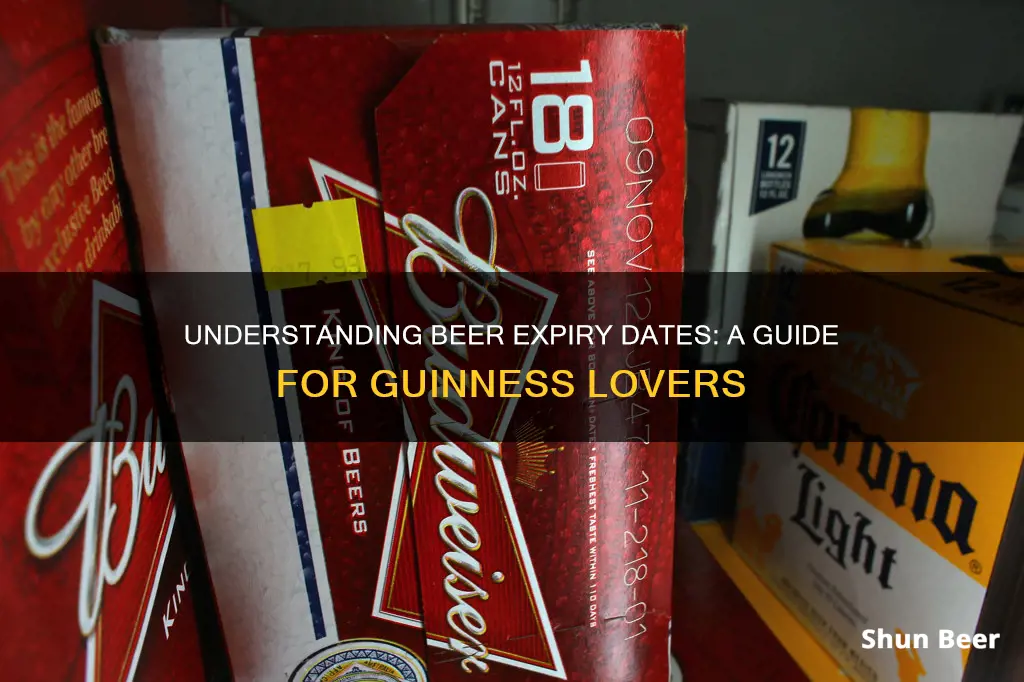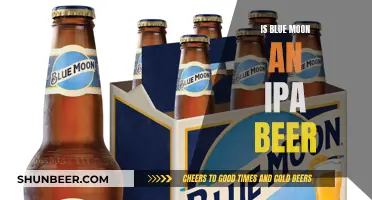
Reading beer expiration dates can be tricky, and the codes vary from brand to brand. Guinness Foreign Extra Stout, for example, uses a date code that begins with an L, with the first four digits indicating the year and day. The first digit of the four represents the last number of the year, while the next three digits represent the day of the year, counting from the beginning of January. So, a code of L8206 would mean the beer was bottled on the 206th day of 2018.
| Characteristics | Values |
|---|---|
| Date Format | MMDDYY |
| Expiry Date | 1218 = December 2018 |
| Expiry Date Location | Bottom of can |
| Expiry Date Location | Neck or shoulder of bottle |
| Expiry Date Location | Case or carrier package |
| Expiry Date Location | Small case packs |
| Expiry Date Code | 4-digit number |
| Expiry Date Code | L6274GF006 |
| Expiry Date Code Interpretation | Ignore the L; the first four numerals matter |
| Expiry Date Code Interpretation | The number “6” represents the year’s last number, 2016 |
| Expiry Date Code Interpretation | The number 274 represents the year’s final day, September 30th |
What You'll Learn

Where to find the date on Guinness packaging
Guinness bottles and cans have an expiration date printed on their labels. This date is an estimate of how long the beer will taste as intended and is not an indication of when the beer will go bad. The date is usually in a month/year format, with the first two numbers indicating the month and the last two indicating the year. For example, if the date on your Guinness is 1218, it means the beer is guaranteed to taste good until December 2018.
On cans, the expiration date is often found on the bottom, while for bottled beer, the date is printed on the neck or shoulder. If you are unable to locate the date on the container, check the case or carrier package. Some breweries also print the expiration date on small case packs like the four-pack or six-pack.
In addition to the expiration date, Guinness bottles and cans also have a lot number. This number is embossed and found to the left of the larger harp device on the packaging. The lot number starts with the letter "L", followed by four digits that correspond to the date. The first digit of the four-digit code represents the last number of the year, while the next three digits represent the day, counting from the beginning of the year. For example, a beer bottled on the 206th day of 2018 would have a code starting with L8206.
Guinness: The Healthiest Beer Option?
You may want to see also

How to interpret the date code
To interpret the date code on a can or bottle of Guinness, you must first locate the code. The date code of Guinness Foreign Extra Stout, for example, is L6274GF006. You can ignore the first letter, as this is just a standard part of the code. The first four numbers are the important part.
The first of these four numbers represents the last digit of the year. For instance, the number "6" in the above example indicates the year 2016. The next three numbers represent the day of the year, so "274" means the 274th day, which is 30th September.
Therefore, the date code L6274GF006 translates to 30th September 2016.
It is worth noting that the expiration date on a Guinness product is not an indication of when the beer will go bad, but rather when the brewery can no longer guarantee the beer will taste as intended.
Guinness Beer: The Sparkling Truth About Carbonation
You may want to see also

What the date means in terms of taste and safety
The expiration date on a can or bottle of Guinness is not an indication of when the beer will become unsafe to drink. Instead, it is the brewery's guarantee of the optimal taste of the beer. The first two numbers of the date indicate the month, and the last two indicate the year. For example, a can of Guinness with the expiration date of 1218 is guaranteed to taste good until December 2018.
Guinness, like most beers, will be safe to drink long after its expiration date. However, the taste may not be as fresh as when it was first brewed. It is recommended to drink Guinness within a few months of the expiration date to ensure the best taste.
Although expired Guinness is not harmful to health, it may lose its flavor and become sour over time. The expiration date indicates when the beer is no longer guaranteed to be fresh.
Guinness, like other beers, is a natural product brewed from organic plant ingredients that degrade over time. This degradation process affects the taste and flavor of the beer, making it less enjoyable to drink. However, it is important to note that the speed of degradation and oxidation is influenced by the storage temperature. Proper storage in a dark, cool place, preferably a refrigerator, can help preserve the flavor of Guinness for a longer period.
Guinness Beer: Healthy or Harmful?
You may want to see also

How to tell if Guinness has gone bad
Guinness, like all beer, will eventually go bad. However, it is important to note that the expiration date on a can or bottle of Guinness is not an indication of when it will go bad, but rather when the brewery can no longer guarantee its intended taste. This means that Guinness (and most other beers) will still be safe to drink long after the expiration date.
Reading Expiration Dates
Guinness uses a unique system to indicate the expiration date of its products. On the label, you will find a lot number, which is an embossed number to the left of the larger harp device, starting with the letter "L". The four digits following the "L" are the code for the date. The first digit indicates the year, and the next three digits represent the day, counting from the beginning of the year. For example, a code of "L8206" would mean the beer was bottled on the 206th day of 2018.
Signs of Spoilage
While it is unlikely for Guinness to go bad before its expiration date, it can happen, especially if it has not been stored properly. Here are some signs that your Guinness has gone bad:
- Unpleasant taste or smell: If your Guinness has an off-putting taste or smell, such as cardboard, rotten vegetables, or diapers, it has likely gone bad.
- Flat taste: If your Guinness has lost its carbonation and tastes flat, it may be past its prime.
- Color change: A change in the color of the beer can be a sign of spoilage.
- Settling: If you notice a "dusty" settling at the bottom of the bottle, it could indicate that the beer is outdated.
- Exposure to light or heat: If your Guinness has been exposed to sunlight, artificial light, or heat, it may have been skunked, which can affect its taste and freshness.
Storage Tips to Extend Shelf Life
To prevent your Guinness from going bad and to extend its shelf life, it is important to store it properly. Here are some storage tips:
- Keep it cool: Store your Guinness in a cool place, preferably in a refrigerator, to slow down the oxidation process and maintain freshness.
- Protect from light: Keep your Guinness away from direct sunlight or artificial light, as exposure to light can cause skunking and affect the taste.
- Maintain consistent temperature: Try to avoid transporting your Guinness between cold and warm environments, as sudden temperature changes can accelerate the expiration process.
- Store upright: Storing your Guinness upright can help minimize oxidation and reduce the risk of contamination.
In conclusion, while Guinness can last beyond its expiration date, it is best to consume it within a few months of that date to ensure optimal taste and quality. By knowing how to read expiration dates and recognizing the signs of spoilage, you can ensure that your Guinness is fresh and safe to drink.
Guinness Beer: Meat-Free, But What's the Verdict?
You may want to see also

What to do with out-of-date Guinness
Although Guinness does have an expiration date, it is safe to drink long after. The date is more of a best-before guarantee of quality and taste rather than a use-by date. So, if your Guinness is out of date, you can still drink it, but be aware that it may not taste as good. It is likely to smell odd and taste stale or flat.
If you don't fancy drinking your out-of-date Guinness, there are other ways to use it. Due to its high nutrient content, it is perfect for giving your plants a boost. You can also use it as a cleaning product, as the acidity in Guinness is great for cleaning pots and pans and bringing the shine back to gold and silver jewellery.
Guinness can also be used in cooking. It can be added to stews to give them a richer, darker taste or added to BBQ sauce for a wonderful caramelised flavour. It can also be used in baking, as the beer contains yeast, so you won't need to add your own. You can also add some Irish cheddar to make a delicious, beery, cheesy loaf.
Finally, you could use your out-of-date Guinness as a hair mask. The protein-rich stout will boost shine when massaged into your scalp and left for a few minutes before being washed out. For even better results, combine it with avocado, egg white, or banana and apply the mask once a week for at least four weeks.
Guinness Beer: Wheat-Free, But What's the Secret?
You may want to see also
Frequently asked questions
The expiration date is usually printed on the bottom of the can or on the neck/shoulder of the bottle. If you can't find the date, look for a lot number, which will be an embossed number beginning with L, followed by four digits. The first of these four digits represents the end of the year, and the next three digits represent the day, counting from the beginning of the year.
Expired Guinness won't make you sick, but it may not taste as good as a fresh can.
Unopened Guinness stored in the fridge can last for 6-8 months.
If your Guinness has gone bad, it may have a dusty settlement at the bottom of the bottle, or the beer may have changed colour. It will likely taste flat or sour.
If you think your Guinness has gone bad, contact Guinness directly to let them know.







